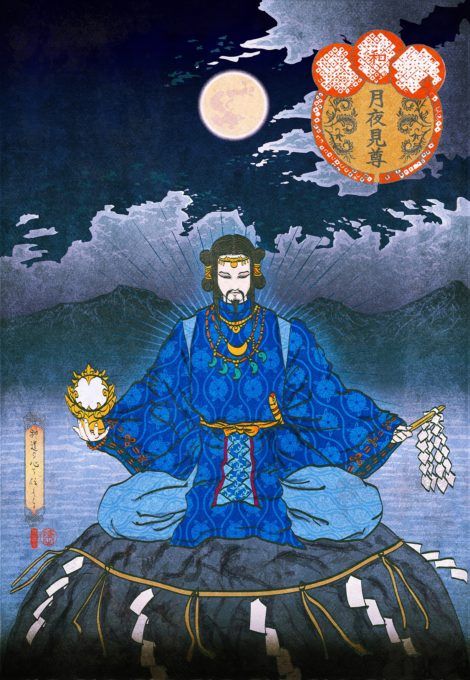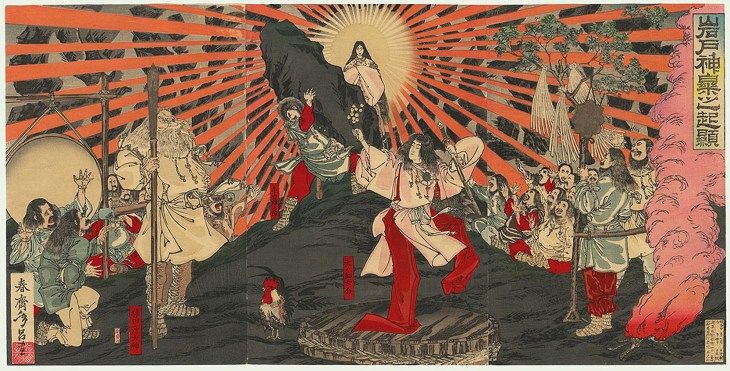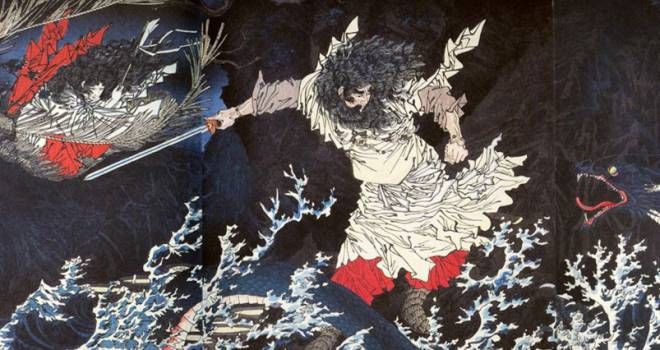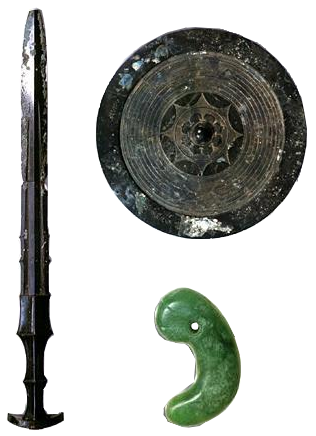Last time, I explained the Japanese creation myth including the story of Izanagi and Izanami. In this post, I'm going to explain what happened next with their Three Precious Children. Their stories gives way for the Imperial Regalia of Japan (三種の神器, sanshu no jingi, "Three Sacred Treasures") and are among the most well known Japanese myths!
Amaterasu, the goddess of the sun, and her brother Tsukuyomi, the god of the moon, were married. Because... you know, that's just what ancient gods did. Together, they lived in the heavens. One day, Uke Mochi (保食神, "The Goddess Who Protects Food"), the goddess of food and cooking, invited Amaterasu over for a feast. Amaterasu couldn't go, so she sent Tsukuyomi to represent her. Once Tsukuyomi arrived, Uke Mochi began to prepare the food; she turned into the ocean and spat out fish, faced the forest and spat out game, then turned into a rice paddy and coughed up rice. The food looked delicious, but Tsukuyomi was so disgusted by the way Uke Mochi produced the food that he killed her. Her body then produced more food: millet, beans, more rice and meat, and even silkworms.
When Tsukuyomi came home, he told Amaterasu what had happened. Amaterasu was so upset with Tsukuyomi for killing Uke Mochi that she labeled him as an evil god and broke up with him. She then moved to a different part of the sky, which is why day and night are now separate.
Amaterasu had a long standing rivalry with her other brother, Susano'o. Their father Izanagi ordered Susano'o to leave the heavens. Susano'o went to Amaterasu to say goodbye, but she was suspicious of him. He proposed a challenge in order to prove his sincerity: they were to take an item from each other and produce gods from it (because that shows you're sincere, right?). Susano'o created five male deities from Amaterasu's necklace, and she created three female deities from his sword. Amaterasu claimed that she had won, because the five male deities were birthed from her necklace, and this upset Susano'o. Overcome with anger, he destroyed Amaterasu's rice fields and threw a giant horse at her loom, which killed her favorite attendant. Amaterasu was incredibly upset and banished Susano'o from heaven; She then hid behind ama-no-iwato (天岩戸, "heavenly rock cave"). With the sun goddess gone, the world was plunged into darkness.

After he was exiled from Heaven, Susano'o ended up near a river in Izumo Province. He heard crying, and found a family of earthly gods: a mother, a father, and a daughter. Susano'o asked them why they were upset, and they explained to him that they used to have eight daughters, but every year for the past seven years, an eight-headed and eight-tailed serpent named Yamata no Orochi (八岐大蛇, "8-branched giant snake") came and ate one of their daughters. They only had one daughter left, and Orochi was coming soon.

Amaterasu then had all three pieces of what would be considered the Imperial Regalia. Kusanagi, the sword, represented valor. Yata-no-Kagami (八咫鏡, "Eight Span Mirror"), the mirror used to lure Amaterasu out of the cave, represented wisdom and truth. Yasakani-no-Magatama (八尺瓊勾玉, "Eight Saka Agate Magatama"), a bead from the tree that mirror hung from, represented benevolence.

What the regalia look like is a mystery, and their locations aren't confirmed. It has been stated that the sword is at Atsusa Shrine in Nagoya, the mirror at Ise Grand Shrine in Mie, and the bead in the Imperial Palace in Tokyo. Throughout their 2000+ years of existence there have been stories of them being lost at sea or stolen, so we may never really know where they are. Wherever they may be, whatever they may look like, the Imperial Regalia and the myths surrounding them certainly have impacted Japanese culture even today.